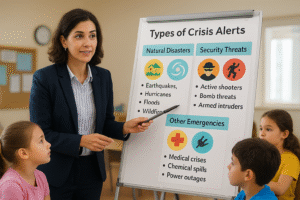Resources

Why SimulAlert® Stands Apart: Not All Emergency Alert Systems Are Created Equal
Introduction
With school safety under constant scrutiny, districts are investing in emergency alert systems—but not all solutions are built for real-world crises. This post breaks down the key differences between one-button badges, app-based platforms, and the SimulAlert® color-coded badge system to help you choose what’s truly effective when seconds matter.
Why Not All Emergency Alert Systems Are Created Equal: Making the Case for SimulAlert®
When it comes to school emergency preparedness, the system you choose can mean the difference between confusion and clarity. Schools are under increasing pressure to invest in school safety solutions that are reliable, fast, and easy for staff to use under stress. With parents asking “What are you doing to keep my child safe?”
Emergency alert systems come in different forms. There are three main types of emergency alert systems for schools being used today: one-button badge systems, app-based alert platforms, and the SimulAlert® color-coded badge system. While each has its strengths, only one is built for true clarity in a crisis. It is critical to evaluate them all
- One-Button Badge Systems: Count to Communicate?
These systems use a single button for multiple types of emergencies—requiring staff to press it a specific number of times to indicate the situation (e.g., press 3 times for lockdown, 5 times for medical). While the concept seems simple, it creates real risk.
During an emergency, staff are not in a mental state to count button presses accurately. This leads to misfires, false alerts, and confusion—hindering school lockdown procedures and delaying crisis response. Without clear context, school incident management becomes reactive instead of proactive.
- App-Based Systems: Feature-Rich but Phone-Dependent
Many app-based platforms offer useful tools like emergency notification systems, two-way communication, and support for school emergency response plans. However, they rely on staff using their personal phones—which isn’t always realistic.
Key limitations include:
- Time lost unlocking phones and navigating apps during high-stress situations
- Not all staff may have their phones readily available during duty
- Dependence on Wi-Fi or cell service, which can fail during critical moments
While these systems offer flexibility, their usability can falter when it matters most—undermining school threat response efforts. For example, Robb Elementary School had implemented an alert app, and when an attacker approached the school, a school employee sent a lockdown alert. But not all teachers received it because of poor Wi-Fi or phones that were turned off or in a drawer, according to an investigation by the Texas Legislature.
- SimulAlert®: Purpose-Built for Speed, Clarity, and Control
SimulAlert® was designed specifically for emergency response in schools, with simplicity and clarity at its core. Its color-coded badge system eliminates guesswork—each button corresponds to a specific emergency type, so staff can signal clearly and confidently without counting or delays.
SimulAlert® includes:
- Visual guides for first responders, displayed at response hubs
- A real-time dashboard for administrators to track evolving situations
- Offline capability—no phones or Wi-Fi required
The system supports school safety best practices and integrates seamlessly into school safety policies, student safety measures, and overall school security planning.
Don’t Just Buy a Tool. Invest in a Safer System.
Your school safety technology should reduce stress, not add to it. Whether you’re updating your school emergency response plans, applying for school safety grants, or conducting a school risk assessment, make sure your alert system supports fast, informed, and accurate action.
SimulAlert® empowers staff, administrators, and responders to act with confidence. It’s a complete solution for school crisis management and a smart addition to any safe school initiative.
SimulAlert® complies with Alyssa’s Law and emerging state-level equivalents by providing an immediate, silent, and reliable alert system that enables on-site personnel to directly notify law enforcement during a life-threatening emergency. The solution meets the core requirements of the law—including real-time communication and accessibility—while going further by eliminating phone dependence and reducing human error under stress
Because when seconds matter, clarity isn’t optional.



